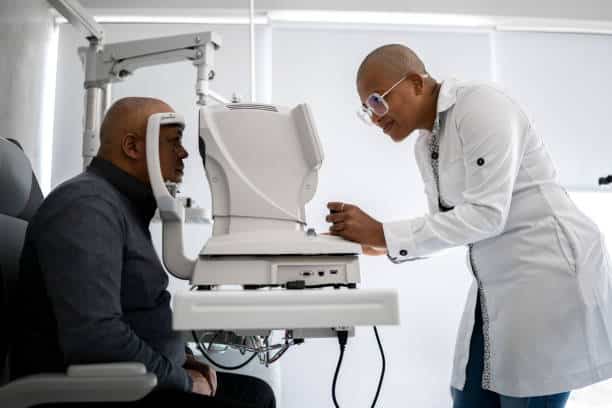
If you are living with diabetes, there are a lot of things you need to be aware of and monitor closely to avoid complications. This includes your eyes, which are at risk of an eye disease called diabetic macular edema (DME) if you have type 1 or type 2 diabetes.
What is diabetic macular edema?
DME is a condition in which fluid builds up in the macula, the center of the eye’s retina, according to the National Eye Institute. “This part of your retina is essential for reading, driving, and seeing people’s faces,” Lee M. Jampol, MD, an ophthalmologist at Northwestern Memorial Hospital and professor of ophthalmology at Northwestern University’s Feinberg School of Medicine in Chicago tells Everyday Health.
One side effect of living with diabetes is that it weakens the blood throughout your body, and your eyes aren’t exempt from this.
“It’s like a leaky pipe that drips on ceiling tiles,” Sunir Garg, MD, a clinical spokesperson for the American Academy of Ophthalmology (AAO) and professor of ophthalmology at Wills Eye Hospital in Philadelphia shares with Everyday Health.“Eventually, the tiles will rot and fall apart.” Similarly, this fluid leakage in the eye causes the macula to become swollen, which can harm your vision.
The key to protecting your eyes before DME develops or catching it early is to see an ophthalmologist regularly, especially if you have diabetes. An ophthalmologist can detect DME via an eye exam. This is important because when left untreated, DME can lead to temporary— or even possibly permanent — loss of central vision, according to Dr. Jampol.
Diabetic Macular Edema Treatment Options
If you do have DME, the good news is that there are several options for treatment:
Injectable drugs
Anti-VEGF (vascular endothelial growth factor) injections work by slowing down blood vessel growth and stopping fluid leaks and are the gold standard for treating DME, Jampol tells Everyday Health.
“As soon as they became available 10 or 12 years ago, it was clear they were the best treatment for DME,” he says.
Anti-VEGF injections are administered through a thin needle. Your doctor will give you a few numbing drops in your eye before the procedure.
“Shots given into the eye sounds terrible, but they’re safe and easy to do, and the result in minimal discomfort,” Jampol adds. You’ll need about nine shots in the first 12 months, followed by four or five shots in the second year and one or two in the third. By year four or five, many people don’t require any, he says.
Steroids
Steroids reduce inflammation in the eye and are available in two forms: injections or time-released implants, according to the AAO.
If you’ve tried anti-VEGF injections and haven’t found any relief, steroids may be a good option.
Steroids are very effective; however, the downside to steroids is that they come with side effects, Dr. Garg notes. Steroids can speed up the growth of a cataract (a clouding of the lens of the eye) and cause eye pressure to increase. Fortunately, both of these side effects are treatable.

Lasers
Lasers use heat to close leaking blood vessels. This method of treatment is great for treating the leaky spots in the macula. “The majority of patients have multiple leaky vessels in multiple small areas, though, making anti-VEGF treatments better,” Dr. Garg shares.
Although once favored, anti-VEGF injections have surpassed lasers as the more common therapy.
Preventing DME
Being diagnosed with DME can be devastating, but the good news is that there are several treatments available to slow or stop the progression of the disease and prevent future damage. Lowering your A1c and maintaining your overall health is also an important part of staying healthy overall if you are living with diabetes.
“We encourage patients to get their blood sugar and blood pressure under control,” Garg notes.

When to See a Doctor for DME Treatment
Patients with diabetes should be referred to an ophthalmologist or retina specialist promptly if any of the following apply:
-
Blurred or fluctuating central vision
— Even mild changes can indicate fluid accumulation in the macula and warrant evaluation. -
Recent diagnosis of diabetic retinopathy
— DME often develops alongside or after diabetic retinopathy. All patients with any level of retinopathy should undergo regular dilated eye exams to detect DME early. -
Poorly controlled blood sugar, blood pressure, or lipid levels
— These systemic risk factors accelerate retinal damage. Referral is indicated even in the absence of symptoms if risk is high. -
Visual symptoms not explained by refractive error
— Any unexplained visual distortion, dark spots, or reduced contrast sensitivity in a patient with diabetes should prompt retinal imaging. -
Previous diagnosis of DME with worsening vision
— Patients receiving anti-VEGF injections or other treatments for DME should follow up immediately if they notice visual decline or new symptoms.
Early detection and treatment of DME are critical. Anti-VEGF injections, corticosteroids, and laser therapy can stabilize or improve vision when started before irreversible damage occurs. Delayed treatment increases the risk of permanent central vision loss.









